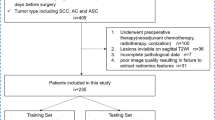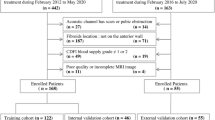Abstract
Objective
To develop and evaluate a T2 MR–based radiomics prediction model incorporating radiomics features and clinical parameters to predict the response to magnetic resonance–guided focused ultrasound surgery (MRgFUS) in patients with adenomyosis.
Materials and methods
Sixty-nine patients (mean age, 38.6 years; age range, 26–50 years) with adenomyosis treated by MRgFUS were reviewed and allocated to training (n = 48) and testing cohorts (n = 21). One thousand one hundred eighteen radiomics features were extracted from T2-weighted imaging before MRgFUS. The radiomics features’ dimension was reduced by Pearson correlation coefficient after normalization. Analysis of variance and logistical regression were used for feature selection by fivefold cross-validation in the training cohort, and the machine learning model was constructed for comparing the clinical model, radiomics model, and radiomics-clinical model which combined survived radiomics features and clinical parameters. The discrimination result of the model was obtained by bootstrap; receiver operating characteristic curve, area under the curve (AUC), and decision curve analyses were performed to illustrate the model performance in both the training and testing cohorts.
Results
Good response was achieved in 47 patients (68.1%) and failed in 22 patients (38.9%). The radiomics model comprised four selected features and demonstrated a degree of prediction capability of patients’ poor response to MRgFUS treatment. The radiomics-clinical model showed good discrimination, with an AUC of 0.81 (95% confidence interval, 0.592–0.975) in the testing cohort. The decision curve analysis also showed favorable performance of the radiomics-clinical model.
Conclusions
A prediction model composed of T2WI-based radiomics features and clinical parameters could be applied to guide the radiologist to evaluate MRgFUS for patients with adenomyosis who will achieve good response.
Key Points
• Magnetic resonance imaging–guided focused ultrasound surgery represents an alternative treatment for adenomyosis, but nearly one third of patients remain symptomatic 6 months after MRgFUS.
• Combining four radiomics features of T2-weighted MRI with eight clinical features further improves prediction of poor responders to MR-guided focused ultrasound treatment of uterine adenomyosis (AUC = 0.81 in the testing cohort).
• The radiomics model based on T2-weighted imaging combined with clinical parameters can help predict which patients are likely to have a good response to MRgFUS for adenomyosis.





Similar content being viewed by others
Abbreviations
- L 3mm3DGLCMinverse variance :
-
T2 log sigma 3–0-mm 3D GLCM inverse variance
- W HLHFOmedian :
-
T2 wavelet HLH first-order median
- W HLLFOminimum :
-
T2 wavelet HLL first-order minimum
- W LLHNGTDMstrength :
-
T2 wavelet LLH NGTDM strength
- AUC:
-
Area under the ROC curve
- DCA:
-
Decision curve analysis
- GR:
-
Good responders
- HIFU:
-
High-intensity focused ultrasound
- MRgFUS:
-
Magnetic resonance–guided focused ultrasound surgery
- NRS:
-
Numerical rating scales (to assess pain severity)
- NSAIDs:
-
Non-steroidal anti-inflammatory drugs
- PR:
-
Poor responders
- ROC:
-
Receiver operating characteristic curve
- SSS:
-
Symptom severity score
- UFS-QOL:
-
Uterine fibroid symptom and quality of life
References
Garavaglia E, Audrey S, Annalisa I et al (2015) Adenomyosis and its impact on women fertility. Iran J Reprod Med 13:327–336
Vercellini P, Vigano P, Somigliana E, Daguati R, Abbiati A, Fedele L (2006) Adenomyosis: epidemiological factors. Best Pract Res Clin Obstet Gynaecol 20:465–477
Azziz R (1989) Adenomyosis: current perspectives. Obstet Gynecol Clin North Am 16:221–235
Struble J, Reid S, Bedaiwy MA (2016) Adenomyosis: a clinical review of a challenging gynecologic condition. J Minim Invasive Gynecol 23:164–185
Nishida M (1991) Relationship between the onset of dysmenorrhea and histologic findings in adenomyosis. Am J Obstet Gynecol 165:229–231
Krentel H, Cezar C, Becker S et al (2017) From clinical symptoms to MR imaging: diagnostic steps in adenomyosis. Biomed Res Int 2017:1514029
Younes G, Tulandi T (2017) Effects of adenomyosis on in vitro fertilization treatment outcomes: a meta-analysis. Fertil Steril 108:483–490.e483
Parazzini F, Mais V, Cipriani S, Busacca M, Venturini P (2009) Determinants of adenomyosis in women who underwent hysterectomy for benign gynecological conditions: results from a prospective multicentric study in Italy. Eur J Obstet Gynecol Reprod Biol 143:103–106
Cline HE, Hynynen K, Watkins RD et al (1995) Focused US system for MR imaging-guided tumor ablation. Radiology 194:731–737
Fan TY, Zhang L, Chen W et al (2012) Feasibility of MRI-guided high intensity focused ultrasound treatment for adenomyosis. Eur J Radiol 81:3624–3630
Fukunishi H, Funaki K, Sawada K, Yamaguchi K, Maeda T, Kaji Y (2008) Early results of magnetic resonance-guided focused ultrasound surgery of adenomyosis: analysis of 20 cases. J Minim Invasive Gynecol 15:571–579
Zhou M, Chen JY, Tang LD, Chen WZ, Wang ZB (2011) Ultrasound-guided high-intensity focused ultrasound ablation for adenomyosis: the clinical experience of a single center. Fertil Steril 95:900–905
Lee JS, Hong GY, Park BJ, Kim TE (2015) Ultrasound-guided high-intensity focused ultrasound treatment for uterine fibroid & adenomyosis: a single center experience from the Republic of Korea. Ultrason Sonochem 27:682–687
Jayaram R, Subbarayan K, Mithraprabhu S, Govindarajan M (2016) Heavy menstrual bleeding and dysmenorrhea are improved by magnetic resonance guided focused ultrasound surgery (MRgFUS) of adenomyosis. Fertil Res Pract 2:8
Guo Y, Duan H, Cheng J, Zhang Y (2017) Gonadotrophin-releasing hormone agonist combined with high-intensity focused ultrasound ablation for adenomyosis: a clinical study. BJOG 124(Suppl 3):7–11
Chen J, Chen W, Zhang L et al (2015) Safety of ultrasound-guided ultrasound ablation for uterine fibroids and adenomyosis: a review of 9988 cases. Ultrason Sonochem 27:671–676
Gillies RJ, Kinahan PE, Hricak H (2016) Radiomics: images are more than pictures, they are data. Radiology 278:563–577
Lambin P, Rios-Velazquez E, Leijenaar R et al (2012) Radiomics: extracting more information from medical images using advanced feature analysis. Eur J Cancer 48:441–446
Aerts HJ, Velazquez ER, Leijenaar RT et al (2014) Decoding tumour phenotype by noninvasive imaging using a quantitative radiomics approach. Nat Commun 5:4006
Blagus R, Lusa L (2013) SMOTE for high-dimensional class-imbalanced data. BMC Bioinformatics 14:106–106
Spies JB, Coyne K, Guaou Guaou N, Boyle D, Skyrnarz-Murphy K, Gonzalves SM (2002) The UFS-QOL, a new disease-specific symptom and health-related quality of life questionnaire for leiomyomata. Obstet Gynecol 99:290–300
Williamson A, Hoggart B (2005) Pain: a review of three commonly used pain rating scales. J Clin Nurs 14:798–804
Yushkevich PA, Piven J, Hazlett HC et al (2006) User-guided 3D active contour segmentation of anatomical structures: significantly improved efficiency and reliability. Neuroimage 31:1116–1128
Gareth James DW, Hastie T, Tibshirani R (2013) The lasso. In: Berra Y (ed) An introduction to statistical learning with applications in R. Springer, Berlin, p 225
Bazot M, Cortez A, Darai E et al (2001) Ultrasonography compared with magnetic resonance imaging for the diagnosis of adenomyosis: correlation with histopathology. Hum Reprod 16:2427–2433
Stamatopoulos CP, Mikos T, Grimbizis GF et al (2012) Value of magnetic resonance imaging in diagnosis of adenomyosis and myomas of the uterus. J Minim Invasive Gynecol 19:620–626
Reinhold C, McCarthy S, Bret PM et al (1996) Diffuse adenomyosis: comparison of endovaginal US and MR imaging with histopathologic correlation. Radiology 199:151–158
Takeuchi M, Matsuzaki K (2011) Adenomyosis: usual and unusual imaging manifestations, pitfalls, and problem-solving MR imaging techniques. Radiographics 31:99–115
Levgur M, Abadi MA, Tucker A (2000) Adenomyosis: symptoms, histology, and pregnancy terminations. Obstet Gynecol 95:688–691
Taran FA, Weaver AL, Coddington CC, Stewart EA (2010) Understanding adenomyosis: a case control study. Fertil Steril 94:1223–1228
Shrestha A (2012) Risk factors for adenomyosis. J Nepal Health Res Counc 10:229–233
Mattonen SA, Tetar S, Palma DA, Louie AV, Senan S, Ward AD (2015) Imaging texture analysis for automated prediction of lung cancer recurrence after stereotactic radiotherapy. J Med Imaging (Bellingham) 2:041010
Mattonen SA, Palma DA, Haasbeek CJ, Senan S, Ward AD (2014) Early prediction of tumor recurrence based on CT texture changes after stereotactic ablative radiotherapy (SABR) for lung cancer. Med Phys 41:033502
Liu Z, Zhang XY, Shi YJ et al (2017) Radiomics analysis for evaluation of pathological complete response to neoadjuvant chemoradiotherapy in locally advanced rectal cancer. Clin Cancer Res 23:7253–7262
Acknowledgments
This research is financially supported by the National Natural Science Foundation of China (81871400, 81671740, 81771816, and 61731009), the Shanghai Academic/Technology Research Leader Program (17XD1424200), and the Excellent Academic Leaders of Shanghai of the Shanghai Municipal Commission of Health (2017BR038).
Funding
This study has received funding from the National Natural Science Foundation of China, Shanghai Academic/Technology Research Leader Program, and Excellent Academic Leaders of Shanghai of the Shanghai Municipal Commission of Health.
Author information
Authors and Affiliations
Corresponding author
Ethics declarations
Guarantor
The scientific guarantor of this publication is Han Wang.
Conflict of interest
The authors of this manuscript declare no relationships with any companies, whose products or services may be related to the subject matter of the article.
Statistics and biometry
One of the authors has significant statistical expertise.
Informed consent
Written informed consent was waived by the Institutional Review Board.
Ethical approval
Institutional Review Board approval was obtained.
Study subjects or cohorts overlap
Some study subjects or cohorts have been previously reported in European Radiology.
Methodology
• retrospective
• diagnostic or prognostic study/observational/performed at one institution
Additional information
Publisher’s note
Springer Nature remains neutral with regard to jurisdictional claims in published maps and institutional affiliations.
Electronic supplementary material
ESM 1
(DOCX 137 kb)
Rights and permissions
About this article
Cite this article
Li, Z., Zhang, J., Song, Y. et al. Utilization of radiomics to predict long-term outcome of magnetic resonance–guided focused ultrasound ablation therapy in adenomyosis. Eur Radiol 31, 392–402 (2021). https://doi.org/10.1007/s00330-020-07076-1
Received:
Revised:
Accepted:
Published:
Issue Date:
DOI: https://doi.org/10.1007/s00330-020-07076-1




